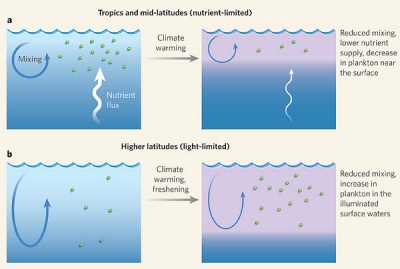6. Plankton Blooms
Why are phytoplankton important?
The oceans contain phytoplankton (microscopic algae or plants) the oceanic equivalent of terrestrial vegetation. Phytoplankton are the basic element of the oceanic food chain (often referred to as the primary producers).
1 cubic metre of seawater may contain millions of phytoplankton.
Phytoplankton are also important because of their effect on climate. They contain chlorophyll and use carbon dioxide in photosynthesis just as plants on land do. The carbon dioxide they use is absorbed by the ocean from the atmosphere.
Light and nutrients
Phytoplankton require light and nutrients as well as carbon dioxide in order to grow. The amount of light and nutrients available to phytoplankton varies across the globe and with the season.
In tropical areas there is plenty of light but often low quantities of nutrients. We refer to these areas as nutrient limited; phytoplankton will grow until all the nutrients have been used up. At higher latitudes there are often plenty of nutrients available but sufficient light for only part of the year, light limited.
Spring bloom
In some areas there are significant increases in population that occur over a few days or weeks. These are known as phytoplankton “blooms”. In the North Atlantic a bloom occurs in spring because of
- Increased sunlight
- Changes in the ocean surface waters so that phytoplankton spend more time in the sunlit waters (the euphotic zone)
- Availability of nutrients from deep winter mixing
- Fewer zooplankton to act as predators
Ocean colour images give us a measure of the amount of chlorophyll present, and so an indication of the amount of phytoplankton present. We can use satellite images to follow changes like the spring bloom in the Atlantic. We can also look for changes from year to year. There may also be trends associated with climate change, for example with changes in water temperature.

Source: NASA
See the tutorials on Ocean Colour and Ocean Currents for more about phytoplankton and their importance.

Source: NOAA
Will changing climate affect phytoplankton?
The diagram below shows some of the likely effects on phytoplankton due to increased ocean surface temperature. The right hand diagram of each pair shows conditions at present - the nutrient limited case in the tropics and the light limited case at higher latitudes.
Changes in surface temperature may affect ocean circulation and mixing of deeper waters to the surface. The quantities of nutrients near the surface may be affected by these changes in circulation. Access to light may be improved in some areas.

a, In the tropics and at mid-latitudes, phytoplankton are typically nutrient-limited, and satellite data tie reduced biological productivity to upper-ocean warming and reduced nutrient supply. b, At higher latitudes, the opposite biological response to future warming, and extra freshwater input, may occur. In these regions, phytoplankton are often light-limited; reduced mixing would keep plankton close to the surface where light levels are higher.
Source: Nature
See the next page in this chapter for details on the way we can use satellite data to look at changes in phytoplankton population
